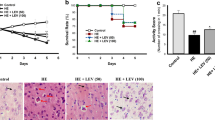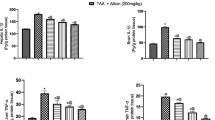Abstract
Hepatic encephalopathy (HE) is a potentially reversible spectral neuropsychiatric state that complicates liver disease and negatively affects the prognosis. This study evaluated the effect of Curcuma longa in acute HE in rat and determined the behavioral, biochemical, and histological changes. Forty male Sprague Dawley rats were randomly divided into the control and three experimental groups. Thioacetamide (TAA, 300 mg/kg) was administered intraperitoneally to induce acute HE. Curcumin was administered orally at doses of 200, 300, and 400 mg/kg. The animals’ behavior, levels of ammonia, alkaline phosohatase (ALP), alanine transaminase (ALT), and aspartate transaminase (AST) enzymes were evaluated. The livers were evaluated histologically too. TAA could successfully induce inflammation and necrosis in hepatic tissue. Regarding the behavioral score, an increase in the dose of curcumin was correlated with a significant decrease in behavioral score. Ammonia, ALP, ALT, and AST levels were significantly lower among curcumin-receiving groups when compared with the control group, which was dose dependent. Histologically, curcumin was shown to reduce inflammation and necrosis in hepatic tissue, which was dose dependent too. Our findings revealed that curcumin could successfully prevent acute HE, which may happen due to a reduction in release of free radicals in the liver.





Similar content being viewed by others
References
Abul H, Mathew TC, Dashti HM, Al-Bader A (2002) Level of superoxide dismutase, glutathione peroxidase and uric acid in thioacetamide-induced cirrhotic rats. Anat Histol Embryol 31:66–71
Aggarwal BB, Kunnumakkara AB (2009) Molecular targets and therapeutic uses of spices: modern uses for ancient medicine. World Scientific, Hackensack
Aggarwal BB, Surh YJ, Shishodia S (2007) The molecular targets and therapeutic uses of curcumin in health and disease. Springer, New York
Alappat L, Awad AB (2010) Curcumin and obesity: evidence and mechanisms. Nutr Rev 68:729–738
Bemeur C, Desjardins P, Butterworth RF (2010) Evidence for oxidative/nitrosative stress in the pathogenesis of hepatic encephalopathy. Metab Brain Dis 25:3–9
Bhatia V, Singh R, Acharya SK (2006) Predictive value of arterial ammonia for complications and outcome in acute liver failure. Gut 55:98–104
Bruck R, Schey R, Aeed H, Hochman A, Genina O, Pines M (2004a) A protective effect of pyrrolidine dithiocarbamate in a rat model of liver cirrhosis. Liver Int 24:169–176
Bruck R, Ashkenazi M, Weiss S, Goldiner I, Shapiro H, Aeed H, Genina O, Helpern Z, Pines M (2007) Prevention of liver cirrhosis in rats by curcumin. Liver Int 27:373–383
Bruck R, Aeed H, Avni Y, Shirin H, Matas Z, Shahmurov M, Avinoach I, Zozulya G, Weizman N, Hochman A (2004b) Melatonin inhibits nuclear factor kappa B activation and oxidative stress and protects against thioacetamide induced liver damage in rats. J Hepatol 40:86–93
Butterworth RF, Norenberg MD, Felipo V, Ferenci P, Albrecht J, Blei AT (2009) Experimental models of hepatic encephalopathy: ISHEN guidelines. Liver Int 29:783–788
Camacho-Barquero L, Villegas I, Sanchez-Calvo JM, Talero E, Sanchez-Fidalgo S, Motilva V, Alarcon de la Lastra C (2007) Curcumin, a Curcuma longa constituent, acts on MAPK p38 pathway modulating COX-2 and iNOS expression in chronic experimental colitis. Int Immunopharmacol 7:333–342
Cerny D, Lekic N, Vanova K, Muchova L, Horinek A, Kmonickova E, Zidek Z, Kamenikova L, Farghali H (2011) Hepatoprotective effect of curcumin in lipopolysaccharide/-galactosamine model of liver injury in rats: relationship to HO-1/CO antioxidant system. Fitoterapia 82:786–791
Chadipiralla K, Reddanna P, Chinta RM, Reddy PV (2012) Thioacetamide-induced fulminant hepatic failure induces cerebral mitochondrial dysfunction by altering the electron transport chain complexes. Neurochem Res 37:59–68
Chi D, Rong L, Wang S, Wang X, Ma L, Shao L (2011) Role of oxidative/nitrative stress in hepatic encephalopathy induced by thioacetamide. Pharmazie 66:378–381
Ciftci O, Ozdemir I, Tanyildizi S, Yildiz S, Oguzturk H (2011) Antioxidative effects of curcumin, beta-myrcene and 1,8-cineole against 2,3,7,8-tetrachlorodibenzo-p-dioxin-induced oxidative stress in rats liver. Toxicol Ind Health 27:447–453
Conley EJ (2006) The breast cancer prevention plan: 20 proven steps for reducing your breast cancer risk. McGraw-Hill, New York
Daube FW (1870) Ueber Curcumin den Farbstoff der Curcuma-Wurzel [Inaug -Diss]. Freiburg i B: Druck von Chr. Lehmann, Freiburg i B.
Farjam M, Dehdab S, Abbassnia F, Mehrabani D, Tanideh N, Pakbaz S, Imanieh MH (2012) Thioacetamide-induced acute hepatic encephalopathy in rat: behavioral, biochemical and histological changes. Iran Red Crescent Med J 14:164–170
Farooqui AA, Farooqui T (2010) Phytochemicals and human health : pharmacological and molecular aspects—a tribute to late Professor Bimal Kumar Bachhawat. Nova Science Publishers, Hauppauge
Fraga CG (2010) Plant phenolics and human health: biochemistry, nutrition, and pharmacology. Hoboken, NJ Wiley
Gorg B, Qvartskhava N, Bidmon HJ, Palomero-Gallagher N, Kircheis G, Zilles K, Haussinger D (2010) Oxidative stress markers in the brain of patients with cirrhosis and hepatic encephalopathy. Hepatology 52:256–265
Hamaguchi T, Ono K, Yamada M (2010) Curcumin and Alzheimer’s disease. CNS Neurosci Ther 16:285–297
Haugen S, Meijer S (2010) Handbook of nutritional biochemistry: genomics, metabolomics and food supply. Nova Science Publishers, New York
Kelkel M, Jacob C, Dicato M, Diederich M (2010) Potential of the dietary antioxidants resveratrol and curcumin in prevention and treatment of hematologic malignancies. Molecules 15:7035–7074
Kosenko E, Kaminsky Y, Kaminsky A, Valencia M, Lee L, Hermenegildo C, Felipo V (1997) Superoxide production and antioxidant enzymes in ammonia intoxication in rats. Free Radic Res 27:637–644
Lemberg A, Fernandez MA (2009) Hepatic encephalopathy, ammonia, glutamate, glutamine and oxidative stress. Ann Hepatol 8:95–102
Messner DJ, Sivam G, Kowdley KV (2009) Curcumin reduces the toxic effects of iron loading in rat liver epithelial cells. Liver Int 29:63–72
Panjehshahin MR, Owji AA, Mehrabani D, Mirzaee M, Vasei M (2003) Effect of curcumin on cholesterol gall-stone induction in rats. J Appl Anim Res 23:75–80
Rivera-Espinoza Y, Muriel P (2009) Pharmacological actions of curcumin in liver diseases or damage. Liver Int 29:1457–1466
Schiodt FV, Bangert K, Shakil AO, McCashland T, Murray N, Hay JE, Lee WM (2007) Predictive value of actin-free Gc-globulin in acute liver failure. Liver Transpl 13:1324–1329
Schliess F, Gorg B, Haussinger D (2006) Pathogenetic interplay between osmotic and oxidative stress: the hepatic encephalopathy paradigm. Biol Chem 387:1363–1370
Seyan AS, Hughes RD, Shawcross DL (2010) Changing face of hepatic encephalopathy: role of inflammation and oxidative stress. World J Gastroenterol 16:3347–3357
Shapiro H, Ashkenazi M, Weizman N, Shahmurov M, Aeed H, Bruck R (2006) Curcumin ameliorates acute thioacetamide-induced hepatotoxicity. J Gastroenterol Hepatol 21:358–366
Shawcross D, Jalan R (2005) The pathophysiologic basis of hepatic encephalopathy: central role for ammonia and inflammation. Cell Mol Life Sci 62:2295–2304
Shehzad A, Lee J, Lee YS (2013) Curcumin in various cancers. Biofactors 39(1):56–68
Sherlock S, Dooley J (2002) Hepatic encephalopathy. In: diseases of the liver and biliary system, 11 edn. Blackwell Science Ltd, UK, pp 93–107
Srivastava RM, Singh S, Dubey SK, Misra K, Khar A (2011) Immunomodulatory and therapeutic activity of curcumin. Int Immunopharmacol 11:331–341
Sun Y, Dai M, Wang Y, Wang W, Sun Q, Yang GY, Bian L (2011) Neuroprotection and sensorimotor functional improvement by curcumin after intracerebral hemorrhage in mice. J Neurotrauma 28(12):2513–2521
Taylor RA, Leonard MC (2011) Curcumin for inflammatory bowel disease: a review of human studies. Altern Med Rev 16:152–156
Wang M, American Chemical Society. Division of Agricultural and Food Chemistry, American Chemical Society Meeting (2006) Herbs: challenges in chemistry and biology. American Chemical Society: Distributed by Oxford University Press, Washington
Wilken R, Veena MS, Wang MB, Srivatsan ES (2011) Curcumin: A review of anti-cancer properties and therapeutic activity in head and neck squamous cell carcinoma. Mol Cancer 10:12
Xie L, Li XK, Takahara S (2011) Curcumin has bright prospects for the treatment of multiple sclerosis. Int Immunopharmacol 11:323–330
Zhou H, Beevers CS, Huang S (2011) The targets of curcumin. Curr Drug Targets 12:332–347
Acknowledgments
The authors would like to thank Shiraz University of Medical Sciences for financial support. Also, they appreciate the helps of Dr. Mahjoob Vahedi and Mr. Khashayar Saraiee from the Laboratory Animal Center, Shiraz University of Medical Sciences, Shiraz, Iran.
Conflict of interest
None declared.
Author information
Authors and Affiliations
Corresponding author
Rights and permissions
About this article
Cite this article
Farjam, M., Mehrabani, D., Abbassnia, F. et al. The healing effect of Curcuma longa on liver in experimental acute hepatic encephalopathy of rat. Comp Clin Pathol 23, 1669–1673 (2014). https://doi.org/10.1007/s00580-014-1883-0
Received:
Accepted:
Published:
Issue Date:
DOI: https://doi.org/10.1007/s00580-014-1883-0




